THASOS Thrace 148BC Dionysus Hercules Silver Greek Tetradrachm Coin NGC i60124
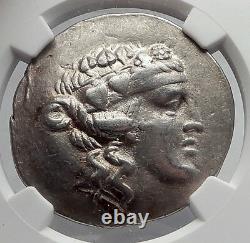
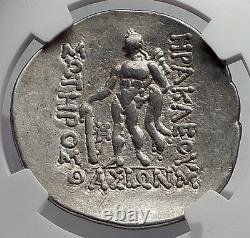
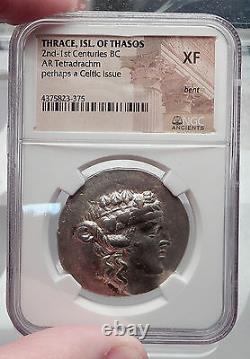
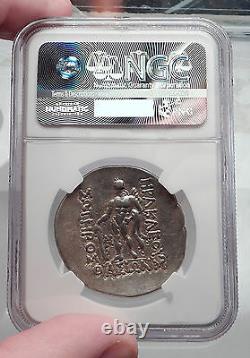
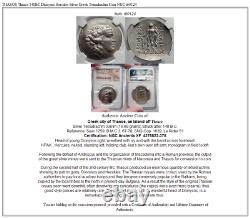


Item: i60124 Authentic Ancient Coin of. Greek city of Thasos, an Island off Thrace Silver Tetradrachm 33mm (16.69 grams) Struck after 148 B. 1039; Le Rider 51 Certification: NGC Ancients XF 4375823-375 Head of young Dionysos right, wreathed with ivy and with the band across forehead. HPAK , Hercules, naked, standing left, holding club, lion's skin over left arm; monogram in field to left.
Following the defeat of Andriscus and the organization of Macedonia into a Roman province, the output of the great silver mines were sent to the Thracian mints of Maroneia and Thasos for conversion to coin. During the second half of the 2nd century BC Thasos produced an enormous quantity of tetradrachms showing its patron gods, Dionysos and Herakles. The Thasian issues were, in fact, used by the Roman authorities to pay local auxiliary troops and they became immensely popular in the Balkans, being copied by the local tribes to the north in present-day Bulgaria. As a result the style of the original Thasian issues soon went downhill, often devolving into caricatures (the copies were even more bizarre); thus good style pieces are relatively rare. The present piece, with its wonderful head of Dionysos, is a remarkably appealing example, quite rare thus.
Is the god of the grape harvest, winemaking and wine, of ritual madness, fertility, theatre and religious ecstasy in Greek mythology. Alcohol, especially wine , played an important role in Greek culture with Dionysus being an important reason for this life style. His name, thought to be a theonym in Linear B tablets as di-wo-nu-so (KH Gq 5 inscription), shows that he may have been worshipped as early as c.
15001100 BC by Mycenean Greeks ; other traces of the Dionysian-type cult have been found in ancient Minoan Crete. His origins are uncertain, and his cults took many forms; some are described by ancient sources as Thracian, others as Greek. In some cults, he arrives from the east, as an Asiatic foreigner; in others, from Ethiopia in the South.
He is a god of epiphany , "the god that comes", and his "foreignness" as an arriving outsider-god may be inherent and essential to his cults. He is a major, popular figure of Greek mythology and religion , and is included in some lists of the twelve Olympians.
Dionysus was the last god to be accepted into Mt. He was the youngest and the only one to have a mortal mother.
His festivals were the driving force behind the development of Greek theatre. He is an example of a dying god.
The earliest cult images of Dionysus show a mature male, bearded and robed. He holds a fennel staff, tipped with a pine-cone and known as a thyrsus.
Later images show him as a beardless, sensuous, naked or half-naked androgynous youth: the literature describes him as womanly or "man-womanish". In its fully developed form, his central cult imagery shows his triumphant, disorderly arrival or return, as if from some place beyond the borders of the known and civilized. His procession (thiasus) is made up of wild female followers (maenads) and bearded satyrs with erect penises.
Some are armed with the thyrsus , some dance or play music. The god himself is drawn in a chariot, usually by exotic beasts such as lions or tigers, and is sometimes attended by a bearded, drunken Silenus.This procession is presumed to be the cult model for the human followers of his Dionysian Mysteries. In his Thracian mysteries, he wears the bassaris or fox -skin, symbolizing a new life. Dionysus is represented by city religions as the protector of those who do not belong to conventional society and thus symbolizes everything which is chaotic, dangerous and unexpected, everything which escapes human reason and which can only be attributed to the unforeseeable action of the gods. Also known as Bacchus , the name adopted by the Romans and the frenzy he induces, bakkheia. His thyrsus is sometimes wound with ivy and dripping with honey.
It is a beneficent wand but also a weapon, and can be used to destroy those who oppose his cult and the freedoms he represents. He is also called Eleutherios ("the liberator"), whose wine, music and ecstatic dance frees his followers from self-conscious fear and care, and subverts the oppressive restraints of the powerful. Those who partake of his mysteries are possessed and empowered by the god himself. His cult is also a "cult of the souls"; his maenads feed the dead through blood-offerings, and he acts as a divine communicant between the living and the dead.
In Greek mythology, he is presented as a son of Zeus and the mortal Semele , thus semi-divine or heroic : and as son of Zeus and Persephone or Demeter , thus both fully divine, part- chthonic and possibly identical with Iacchus of the Eleusinian Mysteries. Some scholars believe that Dionysus is a syncretism of a local Greek nature deity and a more powerful god from Thrace or Phrygia such as Sabazios or Zalmoxis. Heracles , born Alcaeus (Alkaios) or Alcides , was a divine hero in Greek mythology , the son of Zeus and Alcmene , foster son of Amphitryon and great-grandson and half-brother (as they are both sired by the god Zeus) of Perseus.
He was the greatest of the Greek heroes, a paragon of masculinity, the ancestor of royal clans who claimed to be Heracleidae and a champion of the Olympian order against chthonic monsters. In Rome and the modern West , he is known as Hercules , with whom the later Roman emperors , in particular Commodus and Maximian , often identified themselves.
The Romans adopted the Greek version of his life and works essentially unchanged, but added anecdotal detail of their own, some of it linking the hero with the geography of the Central Mediterranean. Details of his cult were adapted to Rome as well. Extraordinary strength, courage , ingenuity, and sexual prowess with both males and females were among the characteristics commonly attributed to him. Heracles used his wits on several occasions when his strength did not suffice, such as when laboring for the king Augeas of Elis , wrestling the giant Antaeus , or tricking Atlas into taking the sky back onto his shoulders. Together with Hermes he was the patron and protector of gymnasia and palaestrae. His iconographic attributes are the lion skin and the club.These qualities did not prevent him from being regarded as a playful figure who used games to relax from his labors and played a great deal with children. By conquering dangerous archaic forces he is said to have "made the world safe for mankind" and to be its benefactor. Heracles was an extremely passionate and emotional individual, capable of doing both great deeds for his friends (such as wrestling with Thanatos on behalf of Prince Admetus , who had regaled Heracles with his hospitality, or restoring his friend Tyndareus to the throne of Sparta after he was overthrown) and being a terrible enemy who would wreak horrible vengeance on those who crossed him, as Augeas, Neleus and Laomedon all found out to their cost. Is a Greek island in the northern Aegean Sea , close to the coast of Thrace and the plain of the river Nestos but geographically part of Macedonia.
And it is where Clive Cussler novel "The Mediterranean Caper" takes place. Lying close to the coast of Eastern Macedonia, Thasos was inhabited from the Palaeolithic period onwards, but the earliest settlement to have been explored in detail is that at Limenaria where Middle and Late Neolithic remains have been found which relate closely to those of the Drama Plain. In contrast, the remains of the Early Bronze Age on the island align it with the culture which developed in the Cylcades and Sporades to the south in the Aegean.At Skala Sotiros for example, a small settlement was encircled by a strongly built defensive wall. Even earlier activity is demonstrated by the presence of large pieces of'megalithic' anthropomorphic stelai built into these walls which, so far, have no parallels in the Aegean area.
There is then a gap in the archaeological record until the end of the Bronze Age c 1100 BC, when the first burials took place at the large cemetery of Kastri in the interior of the island. Here built tombs covered with small mound of earth were typical until the end of the Iron Age. In the earliest tombs were a small number of locally imitated Mycenaean pottery vessels, but the majority of the hand-made pottery with incised decoration reflects connections eastwards with Thrace and beyond. The island was colonized at an early date by Phoenicians , attracted probably by its gold mines; they founded a temple to the god Melqart , whom the Greeks identified as "Tyrian Heracles" , and whose cult was merged with Heracles in the course of the island's Hellenization. The temple still existed in the time of Herodotus.
An eponymous Thasos, son of Phoenix (or of Agenor, as Pausanias reported) was said to have been the leader of the Phoenicians, and to have given his name to the island. In either 720 or 708 BC, Thasos received a Greek colony from Paros.
It was in a war which the Parian colonists waged with the Saians, a Thracian tribe, that the poet Archilochus threw away his shield. The Greeks extended their power to the mainland, where they owned gold mines which were even more valuable than those on the island.
From these sources the Thasians drew great wealth, their annual revenues amounting to 200 or even 300 talents. Herodotus, who visited Thasos, says that the best mines on the island were those which had been opened by the Phoenicians on the east side of the island facing Samothrace.Thasos was important during the Ionian Revolt against Persia. After the capture of Miletus (494 BC) Histiaeus , the Ionian leader, laid siege. The attack failed, but, warned by the danger, the Thasians employed their revenues to build war ships and strengthen their fortifications. This excited the suspicions of the Persians, and Darius compelled them to surrender their ships and pull down their walls. After the defeat of Xerxes the Thasians joined the Delian confederacy; but afterwards, on account of a difference about the mines and marts on the mainland, they revolted.
The Athenians defeated them by sea, and, after a siege that lasted more than two years, took the capital, Thasos, probably in 463 BC, and compelled the Thasians to destroy their walls, surrender their ships, pay an indemnity and an annual contribution (in 449 BC this was 21 talents, from 445 BC about 30 talents), and resign their possessions on the mainland. In 411 BC, at the time of the oligarchical revolution at Athens, Thasos again revolted from Athens and received a Lacedaemonian governor; but in 407 BC the partisans of Lacedaemon were expelled, and the Athenians under Thrasybulus were admitted.After the Battle of Aegospotami (405 BC), Thasos again fell into the hands of the Lacedaemonians under Lysander who formed a decarchy there; but the Athenians must have recovered it, for it formed one of the subjects of dispute between them and Philip II of Macedonia. In the embroilment between Philip III of Macedonia and the Romans, Thasos submitted to Philip, but received its freedom at the hands of the Romans after the battle of Cynoscephalae (197 BC), and it was still a "free" state in the time of Pliny. It is related, that Byzantine Greek Saint Joannicius the Great in one of his miracles freed the island of Thasos from a multitude of snakes (Venerable Joannicius lived through 8-9 centuries). Thasos was part of the Eastern Roman Empire , later known as Byzantine Empire.
It was captured by the Turks in 1462. Under the Turks the island was known as Ottoman Turkish : Taöz. A brief revolt against Ottoman rule in 1821, led by Hajiyorgis Metaxas, failed.The island was given by the Sultan Mahmud II to Muhammad Ali of Egypt of as a personal fiefdom in the late 1820s, as a reward for Egyptian intervention in the War of Greek Independence (which failed to prevent the creation of the modern Greek state). Egyptian rule was relatively benign (by some accounts Muhammad Ali had either been born or spent his infancy on Thasos) and the island became prosperous, until 1908, when the New Turk regime asserted Turkish control. It had the status of a sanjak in the vilayet of Salonici until the Balkan Wars.
On October 20, 1912 during the First Balkan War , a Greek naval detachment claimed Thasos as part of Greece , which it has remained since. The Bulgarians planned to annex the territory under their control and closed down schools as a first step towards forced Bulgarization. Under Bulgarian rule the island was called Bulgarian.
Mountainous terrain facilitated small-scale resistance activity. The Greek Civil War affected the island in the form of skirmishes and Communist guerilla attacks until 1950, almost a year after the main hostilities were over on the mainland. Thasos , the capital (now informally known as Limenas, or "the port"), stood on the north side of the island, and had two harbors.
Archilochus described Thasos as "an ass's backbone crowned with wild wood, " and the description still suits the mountainous island with its forests of fir and pine. Besides its gold mines, the wine, nuts and marble of Thasos were well known in antiquity.
Thasian wine (a light bodied wine with a characteristic apple scent) was, in particular, quite famous; to the point where all Thasian coins carried the head of the wine god Dionysos on one side and bunches of grape of the other. Today, Thasos is a part of the Kavala prefecture and is the southernmost and the easternmost points in the prefecture.
Under local government reform in the late 1990s, the entire island became a single municipality. Thasos is served ferry routes to and from Kavala and Keramoti. The latter is a port at the eastern portion of the prefecture, close to Kavala International Airport , and has the shortest possible crossing to the island.
Thasos from space, April 1993. Thasos has generally round shape, without deep bays and significant peninsulas. The highest peak, Ypsario or Ipsario, is 1,205 m (3428 ft) high and lies in the eastern half of the island, which is steeper and mostly covered in pine forest. The western half has gentler slopes. While generally mountainous, the terrain is not particularly rugged, as it rises gradually from the coast towards the island center.Most villages were placed inland, as the population was chiefly engaged in agriculture and stockbreeding. Those villages had their harbors at nearest points on the shore, often connected with stairways ("Skalas") and the population gradually migrated there, as tourism began to emerge as an important source of income. Thus, there are several pairs of villages such as MarionSkala Maries, where the former is inland and the latter on the coast. Geological and Metallogenic map of Thasos Island. Thasos island is located in the northern Aegean sea approximately 7 km from the mainland and 20 km south-east of Kavala.
The Island is formed mainly by gneisses , schists and marbles of the Rhodope Massif. Marble sequences, corresponding to the Falacron Marbles intercalated by schists and gneisses, are up to 500m thick and are separated from the underlying gneisses by a transition zone about 300 m thick termed the T-zone consisting of alternances of dolomitic and calcitic marbles intercalated by schists and gneisses. The rocks have undergone several periods of regional metamorphism, to at least upper amphibolite facies, and there was a subsequent phase of retrograde metamorphism. At least three periods of regional deformation have been identified, the most important being large scale isoclinal folding with axes aligned north-west. The T-zone is deformed and is interpreted by some authors as a regional thrust of pre-major folding age.
There are two major high angle fault systems aligned north-west and north-east respectively. A large low-angle thrust cuts the gneiss, schist and marble sequence at the south-west corner of the island, probably indicating an overthrusting of the Serbomacedonian Massif onto the Rodope Massif. The Late Miocene oil-producing Nestos-Prinos basin is located between Thassos island and the mainland.
The floor of the basin is around 1,500 m deep off the Thassos coast(South Kavala ridge; Proedrou, 1988) and up to 4.000-5.000 m in the axial sector between Thassos and the mainland. The basin is filled with Late Miocene-Pliocene sediments, including ubiquitously repeated evaporite layers of rock salt and anhydrite-dolomite which alternate with sandstones, conglomerates, black shales, and uraniferous coal measures (Proedrou, 1979, 1988; Taupitz, 1985). Stratigraphically equivalent rocks on the mainland are clastic sediments with coal beds, marine to brackish fluvial units and travertines. Mining activities for base and precious metals started in the 7th century B.
With the Phoenicians, followed in the 4th century by the Greeks and then the Romans. The mining was both open - pit and underground, and concentrated on the numerous karst hosted calamine deposits for lead and silver although there was also minor exploitation of gold and copper. Worth mentioning is the discovery of a paleolithic addit located at Tzines iron mine, whose age has being estimated at approximately 15.000 years old, Kovkouli et al. 1988 for the exploitation of limonitic ochre. The main agricultural production on the island are honey and olive oil as well as wine , sheep , goat herding and fishing.
Other industries includes lumber and tourism. Mining industry includes lead, zinc and marble, especially in the Panagia area where one of the mountains near the Thracian Sea has a large marble quarry. Now abandoned marble quarry in the south (in the area of Aliki) has been mined during the ancient times. By far the most important economic activity is tourism. Ilya Zlobin, world-renowned expert numismatist, enthusiast, author and dealer in authentic ancient Greek, ancient Roman, ancient Byzantine, world coins & more. Ilya Zlobin is an independent individual who has a passion for coin collecting, research and understanding the importance of the historical context and significance all coins and objects represent. Send me a message about this and I can update your invoice should you want this method. Getting your order to you, quickly and securely is a top priority and is taken seriously here.Great care is taken in packaging and mailing every item securely and quickly. What is a certificate of authenticity and what guarantees do you give that the item is authentic? You will be very happy with what you get with the COA; a professional presentation of the coin, with all of the relevant information and a picture of the coin you saw in the listing. Additionally, the coin is inside it's own protective coin flip (holder), with a 2x2 inch description of the coin matching the individual number on the COA.
Whether your goal is to collect or give the item as a gift, coins presented like this could be more prized and valued higher than items that were not given such care and attention to. Is there a number I can call you with questions about my order? When should I leave feedback?
Please don't leave any negative feedbacks, as it happens sometimes that people rush to leave feedback before letting sufficient time for their order to arrive. The matter of fact is that any issues can be resolved, as reputation is most important to me. My goal is to provide superior products and quality of service.How and where do I learn more about collecting ancient coins? Visit the "Guide on How to Use My Store" for on an overview about using my store, with additional information and links to all other parts of my store which may include educational information on topics you are looking for. You may also want to do a YouTube search for the term "ancient coin collecting" for educational videos on this topic. The item "THASOS Thrace 148BC Dionysus Hercules Silver Greek Tetradrachm Coin NGC i60124" is in sale since Friday, March 17, 2017. This item is in the category "Coins & Paper Money\Coins\ Ancient\Greek (450 BC-100 AD)".
The seller is "highrating_lowprice" and is located in Rego Park, New York. This item can be shipped worldwide.
- Grade: XF
- Certification: NGC
- Certification Number: 4375823-375
- Composition: Silver
- Denomination: Tetradrachm
- Culture: Greek
- Material: Silver
- Year: Year_in_description


